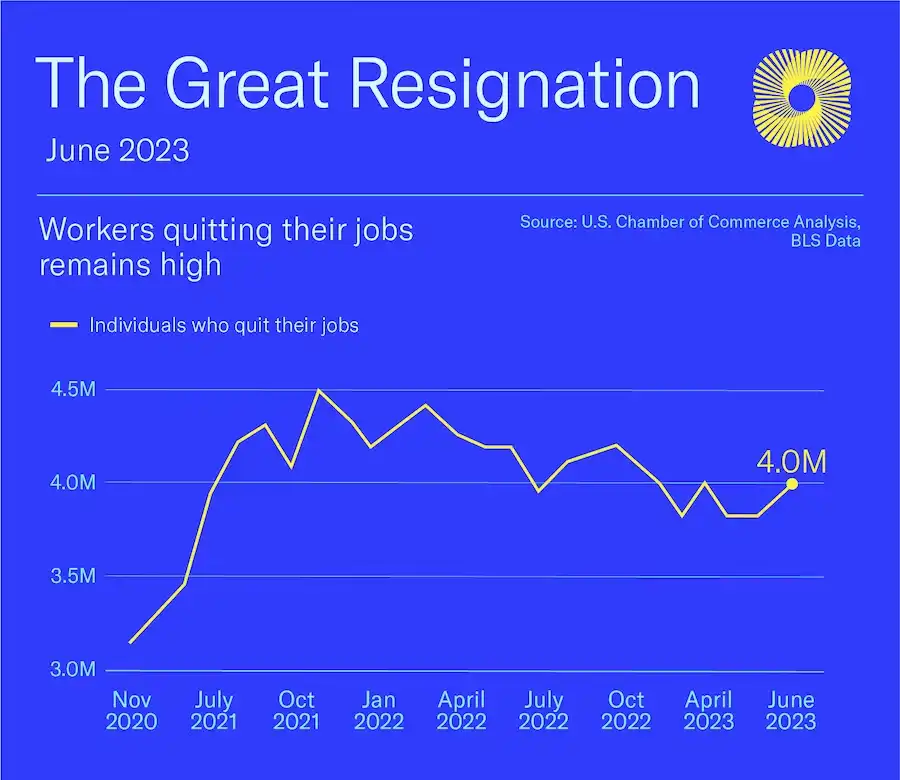The Top 7 Recruiting Challenges And How to Avoid Them
Filling open positions with people that have the skills, experience, and the right personality fit is critical for helping a company be profitable and run smoothly. However, this is no easy task and the list of recruiting challenges resulting from today’s labor shortage just keeps growing.
For instance, in July of 2023, there were over 9.8 million empty positions in the US – and less than 6 million job seekers to fill them. This means that now, more than ever, recruiters need to overcome their recruiting and hiring issues.
In this article, we’ll explore the common challenges being felt by recruiters and discuss how to overcome them or avoid them completely.
Why is Talent Recruitment So Challenging?
Finding good, qualified candidates that your organization can afford and retain is always front of mind for HR teams. However, despite a team’s best intentions, recent shifts in the economy and workforce have made this already complex process more challenging.
Talent Shortages
As mentioned earlier, the job market’s current state is marked by a significant labor shortage. This shortage is not only due to demographic shifts but also changes in career preferences and the skills required for modern jobs.
Moreover, the COVID-19 pandemic has further exacerbated this issue, with many individuals reevaluating their career paths and opting for less traditional roles that offer greater flexibility and prioritize a healthy work-life balance.
The Great Resignation
The phenomenon known as the “Great Resignation” is not just a trending hashtag,it’s real and is impacting employers all across North America. This mass exodus of employees has left many companies understaffed and scrambling to fill essential positions.
Some of the reasons behind this trend include:
- A desire for better work-life balance
- The need for higher wages to meet rising living costs
- A shift in values, with more emphasis on job satisfaction
- The opportunity to explore new career paths or industries

Source: US Chamber of Commerce
Changing Work Environments
Remote and hybrid work environments have become the “new normal” and what employees are increasingly expecting from their employers. However, this shift also poses new challenges for recruiters because it has altered not only where people work, but also how they view their ideal work conditions.
As Brenda Thompson, Director, Operations JER HR Group explains, “The traditional 9-to-5 office job is no longer the norm. Candidates now have different expectations for their work environment, and recruiters need to adapt to these changes to attract top talent.”
7 Challenges in Hiring Employees
Recruiting the right talent is a multifaceted process with its own set of hurdles. These challenges vary depending on the industry, company size, and other unique factors. However, there are some common issues all organizations encounter in their recruitment efforts.
Seven of these challenges include:
- Finding Qualified Candidates: Finding professionals who have the necessary skills, schedule, and can fit the company culture can be challenging.
- Retaining Team Members: High turnover rates make it difficult to get new employees interested in joining a company for a meaningful length of time.
- Company Reputation: Poor brand reputation can make it difficult to attract employees and can even drive away qualified candidates.
- Diversity & Inclusion: Candidates are increasingly looking for companies with strong diversity and inclusion values which can be difficult to prove.
- Adapting to New Work Environments: Today’s workers want more flexible work options and environments that aren’t easy to adapt to.
- Budget Constraints: The best people often come with the highest price tag that a company may not be able to afford.
- Time Constraints: Filling empty positions urgently can limit an HR teams ability to find the best-suited candidates for that job.
10 Helpful Tips to Overcome Your Hiring Challenges
To overcome recruitment challenges, it’s crucial to have a set of effective strategies as part of your hiring processes. However, what those strategies should include isn’t always obvious. Below are eight practical tips that can help your human resource team overcome recruitment hurdles and also build a strong, comprehensive recruitment process.
1. Leverage Technology
Advances in technology have produced solutions that can significantly streamline your recruitment process. From applicant tracking systems to AI-powered screening tools, technology can automate repetitive tasks and free up your time for more strategic activities.
Moreover, don’t forget to incorporate social media and online job platforms. These can help you reach a wider pool of candidates, increasing your chances of finding the right fit for your organization.
2. Offer Competitive Benefits
Offering candidates an enticing salary is just the starting point of any good recruitment strategy. To attract and retain top talent, consider offering a range of benefits, such as:
- Flexible work arrangements
- Comprehensive health insurance
- Generous vacation time
- Opportunities for professional development
- Wellness programs
Remember, the key is to offer benefits that align with both your company’s needs and values as well as those of your potential employee. This not only attracts the right candidates, but it also helps to keep your current employees satisfied, engaged, and on the same page as the company.
3. Focus on Employee Retention
Being able to retain candidates for a long time is just as important as attracting them; this should be a consideration in your recruitment strategy. Turnover is costly and can erode both your profits and your organization’s skill set.
Therefore, it’s crucial to invest in your employees’ growth and satisfaction – even before you’ve met them. Ways to encourage employees to stay include providing regular feedback, recognition programs, and opportunities for advancement.
Outlining such initiatives in your recruitment information can go a long way in securing top-talent that plans to stay for the long run.
|
Salary is just one piece of the recruitment puzzle. Learn what else you should consider in our blog: |
4. Improve Organization Branding
A strong, reputable brand identity can make your company stand out in the crowded job market. Also, it’s important to note that a poor reputation can stop qualified candidates from submitting their resume.
A clearly defined brand is about more than just your reputation; it’s about showcasing your company’s culture, values, and mission – features that are key to attracting people with the same values as yours.
Some tips to improve your organization’s branding include
- Highlight your company’s unique culture and values in job postings and on your website.
- Share employee testimonials and success stories.
- Be transparent about your company’s mission and goals.
5. Promote Diversity and Inclusion
Diversity and inclusion in the workplace matters. Not only does it make a company more attractive to today’s workforce, but it brings individuals with different backgrounds, experiences, and perspectives together; this can lead to more innovative and effective problem-solving.
Moreover, a diverse and inclusive workplace can make your company more attractive to a wider range of candidates, helping you to build a more rounded and talented team.
6. Don’t Ignore Your Passive Candidates
After you’ve chosen the right candidate for a job, don’t toss those other applicants’ information in the recycling. If they’ve gotten a good way through your selection process, they may be able to add value to your company in another role. Or, they could be a good consideration for the future.
Keeping a database of all your pre-selected, pre-vetted candidates can make hiring easier for other positions.
7. Create Effective Compensation Strategies
Compensation is more than just a paycheck. It’s a reflection of how a company values its employees and can help an organization reach goals faster. This is why the creation of an effective compensation strategy is crucial to attract and retain top talent.
Valuable compensation strategies need care and consideration to develop.
Start by conducting a thorough market analysis that will help you understand the salary range, expected benefits, and responsibilities for each role in your organization. This will help you offer competitive salaries that attract qualified candidates and prevent your current employees from looking elsewhere.
For help in creating an effective compensation policy, seek help from third-party experts.
8. Adapt to Flexible Work Arrangements
Remote work and flexible schedules are more than just a trend; they are fundamental changes in the way we work and they’re here to stay. To attract a diverse range of candidates, it’s important to adapt your recruitment strategies to these new work arrangements.
Consider offering remote work options or flexible schedules, and highlight these benefits in your job postings. This not only expands your talent pool but also shows that your company is adaptable and responsive to the changing needs of the workforce.
If you haven’t already begun to do so, be sure to incorporate technology into your recruiting processes. Video conferencing, digital applicant management solutions, and AI tools are effective solutions to try.
9. Create Clear Job Descriptions
Job descriptions should be as detailed and clear as possible. This helps to deter unqualified candidates from applying for positions and also sets the stage for what a candidate can expect from an employer and their responsibilities.
10. Invest in Training and Development
Investing in your employees’ professional growth can make your company more attractive to ambitious candidates. It shows that you value your employees and are committed to their career development.
Offer regular training programs, workshops, and opportunities for advancement. This not only helps to upskill your current workforce but also attracts candidates who are eager to learn and grow in their careers.
End Your Talent Sourcing Problems with JER HR Group
It’s no secret that finding and hiring the right people is complex. However, with the right strategies, information, and tools by your side, you can better overcome the inherent challenges of recruiting.
At JER HR Group, we help businesses of all shapes, sizes and industry backgrounds succeed in their hiring processes. With expertise in both for-profit and nonprofit organizations, we have the tools, expertise and experience to help you too.
To overcome recruitment challenges and develop HR strategies that move your organization forward, contact our team today.
The Top 7 Recruiting Challenges And How to Avoid Them
Filling open positions with people that have the skills, experience, and the right personality fit is critical for helping a company be profitable and run smoothly. However, this is no easy task and the list of recruiting challenges resulting from today’s labor shortage just keeps growing.
For instance, in July of 2023, there were over 9.8 million empty positions in the US – and less than 6 million job seekers to fill them. This means that now, more than ever, recruiters need to overcome their recruiting and hiring issues.
In this article, we’ll explore the common challenges being felt by recruiters and discuss how to overcome them or avoid them completely.
Why is Talent Recruitment So Challenging?
Finding good, qualified candidates that your organization can afford and retain is always front of mind for HR teams. However, despite a team’s best intentions, recent shifts in the economy and workforce have made this already complex process more challenging.
Talent Shortages
As mentioned earlier, the job market’s current state is marked by a significant labor shortage. This shortage is not only due to demographic shifts but also changes in career preferences and the skills required for modern jobs.
Moreover, the COVID-19 pandemic has further exacerbated this issue, with many individuals reevaluating their career paths and opting for less traditional roles that offer greater flexibility and prioritize a healthy work-life balance.
The Great Resignation
The phenomenon known as the “Great Resignation” is not just a trending hashtag,it’s real and is impacting employers all across North America. This mass exodus of employees has left many companies understaffed and scrambling to fill essential positions.
Some of the reasons behind this trend include:
- A desire for better work-life balance
- The need for higher wages to meet rising living costs
- A shift in values, with more emphasis on job satisfaction
- The opportunity to explore new career paths or industries

Source: US Chamber of Commerce
Changing Work Environments
Remote and hybrid work environments have become the “new normal” and what employees are increasingly expecting from their employers. However, this shift also poses new challenges for recruiters because it has altered not only where people work, but also how they view their ideal work conditions.
As Brenda Thompson, Director, Operations JER HR Group explains, “The traditional 9-to-5 office job is no longer the norm. Candidates now have different expectations for their work environment, and recruiters need to adapt to these changes to attract top talent.”
7 Challenges in Hiring Employees
Recruiting the right talent is a multifaceted process with its own set of hurdles. These challenges vary depending on the industry, company size, and other unique factors. However, there are some common issues all organizations encounter in their recruitment efforts.
Seven of these challenges include:
- Finding Qualified Candidates: Finding professionals who have the necessary skills, schedule, and can fit the company culture can be challenging.
- Retaining Team Members: High turnover rates make it difficult to get new employees interested in joining a company for a meaningful length of time.
- Company Reputation: Poor brand reputation can make it difficult to attract employees and can even drive away qualified candidates.
- Diversity & Inclusion: Candidates are increasingly looking for companies with strong diversity and inclusion values which can be difficult to prove.
- Adapting to New Work Environments: Today’s workers want more flexible work options and environments that aren’t easy to adapt to.
- Budget Constraints: The best people often come with the highest price tag that a company may not be able to afford.
- Time Constraints: Filling empty positions urgently can limit an HR teams ability to find the best-suited candidates for that job.
10 Helpful Tips to Overcome Your Hiring Challenges
To overcome recruitment challenges, it’s crucial to have a set of effective strategies as part of your hiring processes. However, what those strategies should include isn’t always obvious. Below are eight practical tips that can help your human resource team overcome recruitment hurdles and also build a strong, comprehensive recruitment process.
1. Leverage Technology
Advances in technology have produced solutions that can significantly streamline your recruitment process. From applicant tracking systems to AI-powered screening tools, technology can automate repetitive tasks and free up your time for more strategic activities.
Moreover, don’t forget to incorporate social media and online job platforms. These can help you reach a wider pool of candidates, increasing your chances of finding the right fit for your organization.
2. Offer Competitive Benefits
Offering candidates an enticing salary is just the starting point of any good recruitment strategy. To attract and retain top talent, consider offering a range of benefits, such as:
- Flexible work arrangements
- Comprehensive health insurance
- Generous vacation time
- Opportunities for professional development
- Wellness programs
Remember, the key is to offer benefits that align with both your company’s needs and values as well as those of your potential employee. This not only attracts the right candidates, but it also helps to keep your current employees satisfied, engaged, and on the same page as the company.
3. Focus on Employee Retention
Being able to retain candidates for a long time is just as important as attracting them; this should be a consideration in your recruitment strategy. Turnover is costly and can erode both your profits and your organization’s skill set.
Therefore, it’s crucial to invest in your employees’ growth and satisfaction – even before you’ve met them. Ways to encourage employees to stay include providing regular feedback, recognition programs, and opportunities for advancement.
Outlining such initiatives in your recruitment information can go a long way in securing top-talent that plans to stay for the long run.
|
Salary is just one piece of the recruitment puzzle. Learn what else you should consider in our blog: |
4. Improve Organization Branding
A strong, reputable brand identity can make your company stand out in the crowded job market. Also, it’s important to note that a poor reputation can stop qualified candidates from submitting their resume.
A clearly defined brand is about more than just your reputation; it’s about showcasing your company’s culture, values, and mission – features that are key to attracting people with the same values as yours.
Some tips to improve your organization’s branding include
- Highlight your company’s unique culture and values in job postings and on your website.
- Share employee testimonials and success stories.
- Be transparent about your company’s mission and goals.
5. Promote Diversity and Inclusion
Diversity and inclusion in the workplace matters. Not only does it make a company more attractive to today’s workforce, but it brings individuals with different backgrounds, experiences, and perspectives together; this can lead to more innovative and effective problem-solving.
Moreover, a diverse and inclusive workplace can make your company more attractive to a wider range of candidates, helping you to build a more rounded and talented team.
6. Don’t Ignore Your Passive Candidates
After you’ve chosen the right candidate for a job, don’t toss those other applicants’ information in the recycling. If they’ve gotten a good way through your selection process, they may be able to add value to your company in another role. Or, they could be a good consideration for the future.
Keeping a database of all your pre-selected, pre-vetted candidates can make hiring easier for other positions.
7. Create Effective Compensation Strategies
Compensation is more than just a paycheck. It’s a reflection of how a company values its employees and can help an organization reach goals faster. This is why the creation of an effective compensation strategy is crucial to attract and retain top talent.
Valuable compensation strategies need care and consideration to develop.
Start by conducting a thorough market analysis that will help you understand the salary range, expected benefits, and responsibilities for each role in your organization. This will help you offer competitive salaries that attract qualified candidates and prevent your current employees from looking elsewhere.
For help in creating an effective compensation policy, seek help from third-party experts.
8. Adapt to Flexible Work Arrangements
Remote work and flexible schedules are more than just a trend; they are fundamental changes in the way we work and they’re here to stay. To attract a diverse range of candidates, it’s important to adapt your recruitment strategies to these new work arrangements.
Consider offering remote work options or flexible schedules, and highlight these benefits in your job postings. This not only expands your talent pool but also shows that your company is adaptable and responsive to the changing needs of the workforce.
If you haven’t already begun to do so, be sure to incorporate technology into your recruiting processes. Video conferencing, digital applicant management solutions, and AI tools are effective solutions to try.
9. Create Clear Job Descriptions
Job descriptions should be as detailed and clear as possible. This helps to deter unqualified candidates from applying for positions and also sets the stage for what a candidate can expect from an employer and their responsibilities.
10. Invest in Training and Development
Investing in your employees’ professional growth can make your company more attractive to ambitious candidates. It shows that you value your employees and are committed to their career development.
Offer regular training programs, workshops, and opportunities for advancement. This not only helps to upskill your current workforce but also attracts candidates who are eager to learn and grow in their careers.
End Your Talent Sourcing Problems with JER HR Group
It’s no secret that finding and hiring the right people is complex. However, with the right strategies, information, and tools by your side, you can better overcome the inherent challenges of recruiting.
At JER HR Group, we help businesses of all shapes, sizes and industry backgrounds succeed in their hiring processes. With expertise in both for-profit and nonprofit organizations, we have the tools, expertise and experience to help you too.
To overcome recruitment challenges and develop HR strategies that move your organization forward, contact our team today.





